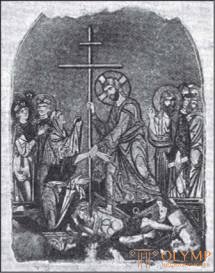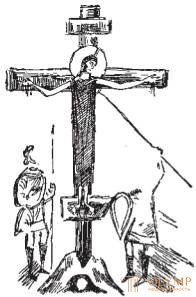
Origin, maturity and death - such is the fate of all individual phenomena, both in natural history and in the history of art. Next to a gradual rise is a gradual decline. The development takes place at all so slowly that the transitions are barely noticeable. From this it appears that the boundaries between the early and the mature, as well as between the mature and the late Middle Ages, are established solely by the need of science to dismember its material. However, taking 1050 and 1250. for the approximate boundaries of the mature Middle Ages, we are based not only on artistic and historical, but also on cultural and historical considerations. In fact, in the West only by the middle of the 11th century, Christianity acquired such power over the minds that Christian hierarchs could oppose the “peace of God” to the coarse fist law; only around the middle of the eleventh century (1054) did the final separation of the Greek church from the Roman church take place, and it was at that time (1057) that a change in dynasty took place in Constantinople, from which the second flowering era of Middle Byzantine art began. The entire period can also be called the century of the crusades, the cause of which, the oppression of the Seljuk Turks by the Palestinian Christians, dates back to the middle of the XI century, whereas the end of it can be considered the capture of the troops of St. Louis in Egypt (1250). The Crusades brought the Christian West into close contact with the Christian East. The Byzantine empire, in contrast to the West, overwhelmed by vague aspirations for novelty, continued to feed on the spiritual and artistic traditions of Hellenistic antiquity, at first took rather passive than active participation in the great popular movement of the crusades; but soon, due to its geographic location, it was drawn into the whirlpool of events, which then absorbed its political independence for half a century. The conquest and plunder of Constantinople by the Crusaders (1204) and the founding of the Latin Empire on the shores of the Bosphorus caused the sudden and premature end of the second epoch of the flourishing of Byzantine art. This middle period of Byzantine art, the art of the Comnin times, is characterized by the greatest schematization of forms, but also by high technical skill and elegance. The art of the times of the Comneni is Byzantine art in the form in which it, with all its weak sides, was imprinted in the memory of posterity, but it is also the Byzantine art that had a strong influence on many Western countries.
The Byzantine architecture, whose history, since the appearance of the work of Choisy, was enriched by numerous monographs of French and German scientists, in this era freely and confidently disposed of the inherited material that formed in the Hellenistic East and received final processing on the shores of the Bosphorus. Of the two already known (see above, Vol. 2, I, 1) main types of early Byzantine church architecture are more ancient, represented by the churches of the monastery of Sts. The bows in Phocis and the monastery in Daphne, in which the lateral pressure of the main dome was transmitted by a strong system of internal buttresses to eight strongholds, was still used in places, albeit with various changes, while the later type, which found expression in the Constantinople Church of Theotokos and used to support the middle dome with only four slender supports and spherical pandantams, it was now increasingly used.
The first, more massive style was kept in the province longer than in the capital. This includes mainly some churches in Greece, for example, the churches of St. Sofia in Monemvasia and in Christian, the first in the south-east, the second in the west of the Peloponnesian peninsula. Among the churches such as Theotokos church (see Fig. 61) belong some temples of Constantinople that are turned into mosques, such as the small church of Monetes Horas (now the Kahriye-Jami mosque) and the pretty one consisting of two small four-column churches with two overlapped the domed church of Pantokrator (Tseirek-Kilise-Jami), the two main rooms of which can serve as models of Theotokos type churches. This type in the XII century also spread in Greece, as evidenced by two elegant churches near Navplia - Nea Moni and Merbaka. Finally, if we look at Mount Athos, we will find there two churches built, apparently, before 1300, namely the original domeless church of Prothaton in Kariës and the church in Vatoped, the plan of which was adopted later by all later Athos churches, expanded with two semicircular niches on the northern and southern sides of the domed quadrilateral, so that in its general plan there is a similarity with a leaf of clover. But especially characteristic of these small, more elegant, than majestic, churches are high drums with arched windows between domes and roofs, beautifully and picturesquely dissected from the outside. The interior of all Byzantine churches was still decorated with luxurious mosaics glittering with gold and soft tones of colors.

Fig. 121. The descent of Christ into hell. Mosaic of the Daphne monastery. By millet
If the purely Byzantine works of this genus served as models for the Byzantine art of Italy, then, on the other hand, the mosaics made by Greek masters in the Holy Land during the crusades reveal the reverse influence of Western art, especially clearly manifested in the remains of mosaics in 1169 in the Church of the Nativity Of Christ (see above, v. 1, ii, 1) in Bethlehem. The genealogy of Christ (the depiction of his ancestors) and church councils (images of church buildings) were depicted here. Between the windows of the longitudinal body are the colossal figures of angels; both the upper and lower wall paintings were girded with deciduous wreath friezes. From the totality of these mosaics blows western spirit.
Some of the works of easel painting, preserved in the Athos monasteries and Western collections and once adorned the walls of Greek churches, date, perhaps, to the XII century. It is easier than these works to be defined by modern Byzantine miniatures.
Various books of spiritual content, which were in use in the previous era (see above, Vol. 2, II, 2), were now the scene of the artistic activity of miniaturists. But individual plots took on the typical form in which they continued to clothe themselves in later Byzantine mosaics and miniatures. Golden backgrounds have become the only commonly used. Luxurious ornaments, made up of schematized antique elements and new, floral patterns, often related to Arab-Persian, filled with broader than before, fields of manuscripts. In the initials, never reaching such sizes as in the West, along with the heavy leafy motifs, graceful ornaments made up of animal and human forms prevailed. Human figures were strongly stretched in length, movements lost their vitality and were made forced; sometimes clothes were depicted hard, without folds or with tight, stiff folds; Persons were given lifeless, shriveled, senile features characteristic of the late Byzantine miniatures. In the middle of the XI century, the color is often still bright and clear; in it the pink and azure tones are in perfect harmony with gold; but during the twelfth century the paints become darker and dull. To simulate the body instead of greenish shadows, olive and brown are used. For all that, many manuscripts of the Comnenian era are true masterpieces.

Fig. 122. Crucifixion. Miniature of the Byzantine Psalter. By Tikkanen
In the field of illustrating the Psalter, in pen-shaped miniatures of the “folk” style (see fig. 64–66), the difference between the forms of the Macedonian and Comnenian eras is immediately apparent if we compare, with Tikkanen's plays, the figures of the Khlud Psalter (see fig. 64) with long, numb, low-head figures Psalms of the British Museum, written in 1066
Such forms can be seen, for example, in a miniature depicting the Crucifixion (Fig. 122).
The most famous monuments of the Komninsky court painting belong to the Homily of John Chrysostom, stored in the Paris National Library, written for the emperor Nikifor Votoniat (1078-1081), with shapeless figures, tight folds of clothes and expressionless faces, while the British Museum of the XII century differs from its own skinny figures and hard draperies still dark color characteristic of this regressed century.
The main works of applied painting and at this time were Byzantine silk embroidery. The transitional time (the end of XI - the beginning of the XII century) is stored in the sacristy of the Roman Cathedral of Sts. Peter's magnificent clothes, mistakenly called the "Dalmatic of Charlemagne." On its front is a Savior, depicted in noble forms, sitting on a rainbow. Embroidered images in gold and silver stand out against a blue silk background.
The same forms as in miniatures, but perhaps more of a kind of perfection of technology we find in the best works of the relief plasticity of the era of the Comneni. Among them the most important role is still played by ivory products. How long are the figures, measured body movements, heavy clothes on a beautiful disc of the Paris Cabinet of medals depicting a blessing Savior standing on a dais between the emperor Roman Diogenes (1068-1071) and his wife! How semi-figures of the Savior, Our Lady and Saints are expressive on the bone lid of a 12th-century Byzantine wooden casket. and stored in the Florence National Museum! At that time, Byzantine cast bronze articles also enjoyed worldwide fame, as evidenced by some bronze doors of Italian churches, whose Constantinople origin is certified by documents or inscriptions. For their part, their figured jewelery resembles Nielli in their technique: the embedded pattern is lined with gold and silver wires; arms, heads and legs are formed of noble metal plates and partly enamelled. The four large panels of the middle doors of the cathedral in Amalfi (1066), the doors of the church of Sant'Angelo at the foot of Monte Gargano (1076), as well as the doors of the cathedrals in Troy, Atrani (1087) and Salerno (1099) are excellent examples of this Byzantine technique. In Rome, the best work of this kind was the doors of the old Basilica of San Paolo fuori le Mura, made in Constantinople by Stavraki in 1070 and decorated with images of 54 scenes. Their remains are kept in the sacristy of this basilica. And here the elongation of figures in length is characteristic of the end of the XI century.
The Byzantine art of the Comnenian dynasty, despite its decline in the twelfth century, was still a national, modern Greek art; it still stood at a higher level than the contemporary Western art in terms of its sophistication and understanding of forms; but the independent impulses to the novelty, which distinguished this last, of course, speak more to our heart. Although Byzantine art did not subdue all artistic fields to its influence, it remained the head of European art, especially northeastern, but also Italian, at least in Lower Italy, Sicily and Venice, where, as we shall see, in a number of the sacred hearths blazed its flame.
Что бы оставить комментарий войдите
Комментарии (0)